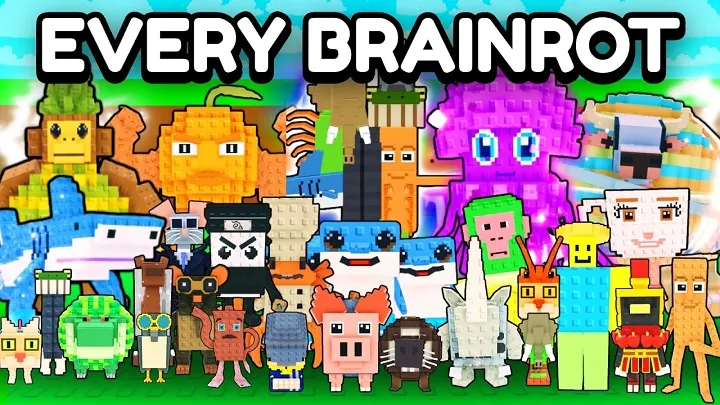Introduction
Roblox has become a playground for creativity where player-driven experiences range from serious simulations to bizarre meme-fueled experiments. One of the latest titles to capture attention is Steal a Brainrot, a chaotic game that thrives on absurdity, humor, and unpredictable interactions. At its core, the game is about snatching “brainrots,” strange meme-like entities that symbolize the viral and nonsensical side of internet culture.
Yet behind the laughter lies a significant issue: the balance between humor-driven chaos and structured gameplay. Unlike traditional Roblox games with clear objectives, progression systems, or competitive frameworks, Steal a Brainrot straddles a thin line between being wildly entertaining and utterly confusing. This article examines how this issue unfolds across time — from the first minutes of play to long-term community involvement — and what it means for the game’s identity.
First Impressions of Absurd Chaos
When new players first enter Steal a Brainrot, the immediate reaction is usually confusion mixed with laughter. The environment is filled with surreal visuals, distorted audio, and nonsensical objects. The lack of a tutorial reinforces the sense that nothing is meant to make sense.

At this early stage, chaos works in the game’s favor. Players laugh at the randomness, share clips with friends, and embrace the unpredictability. The first impression is not about skill but about experiencing something so strange that it becomes memorable.
Discovering the Core Loop
After a few sessions, players begin to recognize a core gameplay loop: collecting brainrots, protecting them, or sabotaging others. While not explained directly, this emergent structure gives some direction amid the absurdity.
Still, the loop is loose. Unlike games with clear leveling or progression systems, Steal a Brainrot relies heavily on players to create meaning. This is where the tension between chaos and structure first becomes apparent.
Mid-Game Frustrations with Lack of Direction
By the second or third day of consistent play, some players start to feel frustrated. The randomness that was once charming begins to feel shallow without deeper systems to explore.
Without structured goals, players may find themselves repeating chaotic moments without a sense of achievement. The humor still entertains, but the absence of progression creates a plateau. Some players leave, while others double down on role-playing and self-imposed challenges.
Community-Driven Content and Memes
The community plays a massive role in sustaining Steal a Brainrot. Players generate memes, TikTok clips, and inside jokes that extend the game’s lifespan beyond Roblox servers.
This user-driven humor becomes the unofficial progression system. Instead of chasing levels, players chase laughs. The more absurd the interaction, the more shareable the content. For some, this replaces traditional structure; for others, it highlights what the game lacks.
The Challenge of Competitive Balance
Roblox games often succeed when they provide some form of competition, whether it’s racing, combat, or tycoon building. Steal a Brainrot flirts with competition but rarely commits.
Players can sabotage each other, but without formal scoring or ranking, these conflicts feel fleeting. This half-step toward competitiveness creates another tension point. The chaos entertains, but those craving structured victory conditions may leave disappointed.
Psychological Appeal of Pure Chaos
It is important to acknowledge that chaos itself has psychological appeal. The unpredictability creates dopamine spikes, similar to meme culture itself. For younger players especially, the randomness mirrors internet humor and feels authentic to their online identity.
This explains why Steal a Brainrot succeeds despite structural weaknesses. For a certain demographic, the chaos is not a flaw — it is the feature.
The Risk of Burnout
Still, pure chaos carries a risk: burnout. Players who once logged in daily may find themselves drifting away as the novelty fades. The lack of structured progression means there is little incentive to return once the jokes feel repetitive.
This problem is not unique to Steal a Brainrot but is amplified by its design. Without updates or evolving systems, the game risks losing momentum quickly.
Developer Dilemma: Preserve Chaos or Add Structure
For the developers, the central dilemma is clear. Should they preserve the game’s chaotic identity or introduce more structured mechanics? Adding structure risks losing the raw meme energy that defines the game. Keeping chaos risks alienating players who seek longevity.

Possible solutions include:
- Adding light progression systems without overwhelming the humor.
- Seasonal updates that refresh chaotic elements.
- Community-driven events that blend memes with competition.
These approaches could balance both worlds without undermining the game’s identity.
Long-Term Community Identity
Over time, the community itself becomes the structure. Dedicated players build traditions, rules, and meta-humor that sustain the game. What the developers don’t provide in systems, the community provides in culture.
This phenomenon is unique to meme-driven Roblox titles. Games like Steal a Brainrot survive less on design and more on collective creativity. The issue of chaos versus structure may never fully resolve, but the community finds its own answers.
Lessons for Roblox and Meme-Driven Games
Steal a Brainrot reveals important lessons for Roblox developers and meme-driven game design. Humor and absurdity can create explosive popularity, but sustaining engagement requires at least some scaffolding.
Future meme-inspired Roblox games might blend humor with clearer mechanics, ensuring players laugh while still having a reason to return. The challenge lies in balancing authenticity with durability — something Steal a Brainrot struggles with but also highlights as a vital design frontier.
Conclusion
Steal a Brainrot thrives on its chaotic humor, making it one of Roblox’s most memorable meme-driven experiences. Yet, the lack of structured gameplay creates long-term challenges. The tension between chaos and structure defines the game’s identity, community culture, and lifespan.
For some players, the randomness is enough — they log in to laugh, share clips, and move on. For others, the absence of progression or competition leaves them unsatisfied. This divide makes Steal a Brainrot both fascinating and fragile, a reflection of internet culture itself: chaotic, hilarious, but hard to sustain.

















